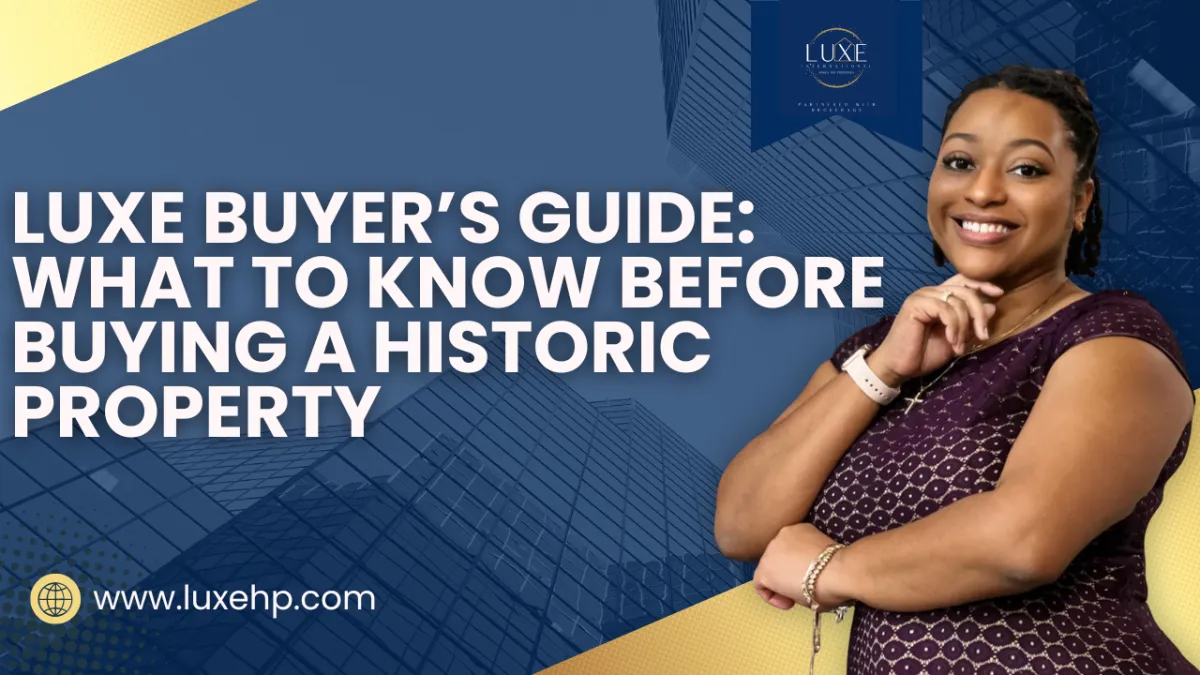
🏡 Luxe Buyer’s Guide: What to Know Before Buying a Historic Property
Presented by Luxe International Homes & Properties – Serving South Georgia, Metro Atlanta & Beyond
From hand-carved moldings to classic Southern architecture, historic homes offer timeless charm and character — but also come with unique responsibilities. At Luxe International Homes, we help buyers embrace the beauty of history while understanding the nuances that come with it.
If you're considering purchasing a historic property, here's what you need to know:
🏛️ What Qualifies as a Historic Property?
A property is typically considered historic if it is:
At least 50 years old
Maintains its architectural integrity or cultural significance
Listed on the National Register of Historic Places (NRHP) or part of a local historic district
These designations may impact:
What you can renovate
How the home is marketed or maintained
What restrictions or responsibilities apply
At Luxe, we ensure you’re informed about local classifications before you commit.
🛠️ Are There Restrictions on Renovating a Historic Home?
Yes — and they matter.
Local preservation ordinances may limit changes to:
The home’s exterior appearance
Interior architectural details in some cases
You may need approval from a historic preservation board for:
Window replacements
Painting or exterior color changes
Adding square footage
Installing solar panels or modern tech
At Luxe, we help you research and respect local preservation rules, often during the contingency period to avoid costly surprises.
🔍 What Should I Look for During an Inspection?
Older homes come with their own set of challenges. Inspections should look closely for:
Outdated wiring
Plumbing issues
Aging insulation
Foundation concerns
Lead paint or asbestos
Pro tip: Hire an inspector who specializes in historic homes. Luxe can connect you with the right experts to ensure you're buying with clarity and confidence.
💡 Can I Make Modern Upgrades to a Historic Home?
Yes — but proceed with care.
You can typically install:
New HVAC systems
Smart thermostats
Energy-efficient lighting
However, any changes that affect the exterior or architectural features may need review. These upgrades can be costlier if they require specialized materials or labor.
Luxe will walk with you through what's allowed — and what's smart — before you invest.
💰 Are There Financial Incentives for Restoring a Historic Home?
Yes — and they can be a game-changer.
You may qualify for:
State and local tax credits
Grants
Low-interest renovation loans
Federal tax benefits (if listed on the NRHP)
We help you connect with your State Historic Preservation Office and local planning departments to explore what’s available.
🧱 What Are the Ongoing Maintenance Considerations?
Historic homes require more care — and often period-appropriate materials, such as:
Wood siding
Lime mortar
Slate or clay tile roofing
Repairs may take longer and cost more, especially when specialized contractors are needed. Detailed maintenance records may be required for compliance or resale.
At Luxe, we help buyers prepare for both the beauty and the responsibility of owning history.
🛡️ How Does Buying a Historic Property Affect Insurance?
Insuring a historic home can be more complex. Insurance companies may view them as higher risk due to:
Their age
Unique or irreplaceable features
Specialized repair requirements
You may need:
A restoration policy that uses historically accurate materials
An agent experienced in historic property coverage
We help you compare policies and connect with agents who understand what makes these homes special.
💛 Luxe Means Legacy + Stewardship
Buying a historic property is about more than bricks and beams — it’s about preserving stories and building legacy. At Luxe International Homes & Properties, we guide buyers through every detail with respect for the past and vision for the future.
📞 Ready to Own a Piece of History?
Let’s explore historic homes that fit your goals, lifestyle, and legacy.
✅ Call Lauren Catchings: 229-304-5893
🌐 Visit: www.luxehp.com
📩 DM us to ask about our Luxe Historic Buyer’s Checklist